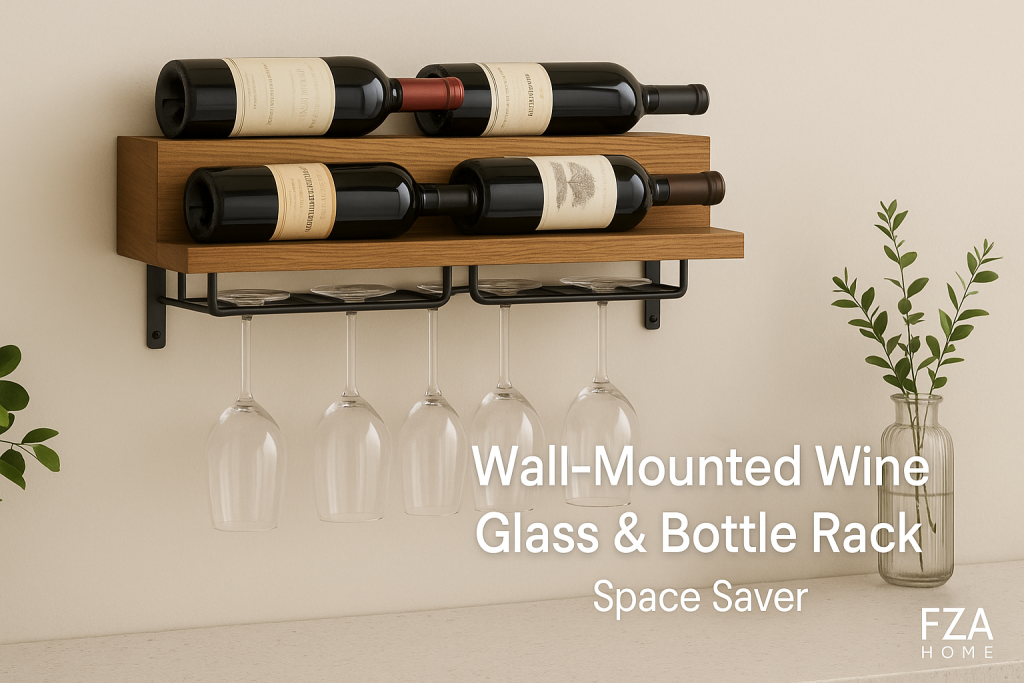
When it comes to making the most of every square inch in your kitchen or bar area, a wall mounted wine glass and bottle rack is the ultimate space-saving solution. More than mere storage, these racks are a design statement—combining practicality with elegance to showcase your favorite wines and glassware. Whether you’re in a tiny apartment, a suburban kitchen, or a luxe home bar, mounting your racks on the wall frees up countertop real estate, keeps glassware within easy reach, and turns your collection into décor. In this comprehensive guide, we’ll explore what these racks are, why they’re so popular, the various styles available, and how to choose the perfect one for your space.
Wall mounted wine racks marry form and function in a way few other storage solutions can. By elevating both bottles and glassware off counters or tucked inside cabinets, they grant easy access while creating an eye-catching focal point. Before diving into styles and materials, let’s clarify exactly what these racks are and why they’ve become so indispensable for wine enthusiasts and home entertainers alike.
What Is a Wall Mounted Wine Glass and Bottle Rack?
At its core, a wall mounted wine glass and bottle rack is a fixture designed to hold both wine bottles and stemmed glassware in one consolidated unit affixed to a wall or underside of cabinetry. They generally feature two key components:
- Bottle Supports or Cradles: These can be horizontal slots, diagonal cubbies, or linear rails that securely hold the bottle’s body, preventing it from rolling or tipping.
- Glass Hangers: A series of parallel metal or wooden rails with narrow gaps that allow the base of a wine glass (the foot) to slide through, suspending the glass by its stem with the bowl hanging below.
By combining both functions, these racks optimize vertical space—your wine is displayed neatly above, glassware hangs safely below, and you avoid cluttered shelving or counter-top stemware trees.
Wall mounted racks come in a variety of configurations, from compact under-cabinet designs that hide out of sight, to decorative floating shelves with integrated hanging slots that turn your collection into a centerpiece. Some modular systems even allow you to expand capacity over time, adding extra sections to accommodate growing collections.
Why Choose a Wall Mounted Rack?
Opting for a wall mounted wine glass and bottle rack offers several compelling advantages:
- Space Efficiency: Vertical mounting frees up precious counter and cabinet space. Ideal for small kitchens, wet bars, or dining nooks.
- Accessibility & Convenience: Glasses and bottles are within arm’s reach—no more rummaging through cabinets or knocking over stemware on crowded shelves.
- Design Impact: Whether sleek stainless steel or warm wood tones, these racks become an integral part of your décor, adding visual interest and a boutique-bar vibe.
- Protection & Organization: Properly secured bottles won’t roll or collide, and stemware hangs safely upside down, reducing dust buildup in the bowl.
- Customizable Layout: Many systems are modular, letting you tailor capacity and arrangement to your space and entertaining needs.
For anyone who loves to entertain or simply enjoys easy access to their favorite vintages, a wall mounted rack elevates both function and style.
Types of Wall Mounted Wine Glass and Bottle Racks
The market offers several distinct styles of wall mounted racks, each with unique advantages. Understanding the main categories will help you narrow down the perfect solution for your space.
Under-Cabinet Mount Racks
Under-cabinet racks install directly to the underside of wall cabinets, keeping the rack completely out of sight until you need it. Key features:
- Hidden Installation: Doesn’t interrupt your backsplash or wall aesthetic.
- Space Optimization: Utilizes the often-unused area under kitchen cabinets or bar hutch.
- Easy Access: Glasses hang ready at head height—no bending or stretching.
- Minimal Visual Impact: Ideal for kitchens with busy backsplashes or patterned tile.
Because they’re tucked away, these racks are perfect for homeowners who prefer a streamlined look. Many under-cabinet models are adjustable, accommodating different glass sizes from flutes to large Burgundy glasses.
Floating Shelf Racks
Floating shelf racks combine an open shelf with built-in stemware hanging slots. They protrude from the wall like a slim shelf, offering:
- Dual Functionality: Display wines and spirits on the shelf, hang glasses below.
- Decorative Appeal: Often constructed from wood, metal, or acrylic, they serve as a display ledge for plants, bar tools, or decanters.
- Showcase Your Collection: Bottles face forward on the shelf, creating a stunning visual.
- Modularity: Many brands allow you to link multiple floating racks side-by-side.
Ideal for living rooms, breakfast nooks, or open-concept layouts, floating shelf racks turn your wine corner into a design highlight.
Combo Wine Glass and Bottle Racks
Combo racks are freestanding or wall-mounted units that integrate both hanging glass storage and bottle capacity in one cohesive framework. Characteristics include:
- Integrated Display: Racks often feature a grid or ladder-style metal frame holding both bottles and glasses.
- High Capacity: Depending on design, can accommodate dozens of bottles and an equal number of glasses.
- Statement Pieces: Bold geometric forms or intricate ironwork lend an industrial, contemporary, or vintage look.
- Versatility: Some units come with additional hooks for bar tools, small shelves for barware, or a top tray for mixing drinks.
If you have a larger collection or want a true centerpiece, combo racks offer maximum storage and visual drama.
Materials and Finishes
When selecting a wall mounted wine glass and bottle rack, the material and finish you choose will largely dictate not only its aesthetic, but also its durability and maintenance requirements. Let’s dive into the most popular options:
Wood (Walnut, Oak, etc.)
Wood brings warmth and character, making it a favorite for those who want their wine display to feel inviting and organic. Walnut offers a deep, rich tone with dramatic grain patterns, ideal for traditional or mid-century modern interiors. Oak—either white or red—presents a lighter, more neutral backdrop that works in rustic, farmhouse, or Scandinavian schemes. Other woods like maple or birch provide a pale, clean look. Solid wood racks can be stained or sealed in various shades, giving you flexibility to match existing cabinetry. Keep in mind that wood is prone to moisture damage if not properly sealed, so look for racks with a high-quality finish or plan to reapply a protective coat every year or two.
Metal (Stainless Steel, Iron)
Metal racks lean into industrial, modern, and minimalist aesthetics. Stainless steel racks have a cool, brushed finish that’s immune to rust and very easy to wipe clean—perfect for humid kitchen environments. Wrought iron or powder-coated steel in black, white, or bold hues (like matte navy or forest green) adds an edgy, artisanal vibe. Metal mounts tend to be slimmer and less visually “heavy” than wood, making them ideal for small spaces. Installation is straightforward, but ensure you’re using the correct anchors for drywall or studs to support the combined weight of bottles and glasses.
Acrylic and Glass
For a truly contemporary, almost “floating” look, acrylic (clear or tinted) and tempered glass racks are hard to beat. The transparency makes your wine and stemware appear to hover against the wall, drawing minimal attention to the hardware itself. Acrylic is surprisingly strong and lightweight, while glass lends extra polish and reflects ambient light. Both materials can scratch more easily than metal, so handle with care and clean with non-abrasive cloths. Mounting hardware is usually hidden to maintain that seamless effect, but be sure the manufacturer provides sturdy brackets or rails to prevent sagging over time.
Key Features to Consider
A great wall mounted rack does more than hold bottles and glasses—it enhances the usability and safety of your bar area. Here are the top factors to evaluate:
Capacity (Glasses and Bottles)
First, inventory your needs. Do you entertain large dinner parties or primarily host intimate gatherings? Standard under-cabinet racks hold 4–8 glasses, while larger floating shelf systems can accommodate 12–16. Bottle capacity likewise varies: simple cubbies might house 4–6 bottles, whereas combo racks hold upwards of 20. Always leave a margin—storing items at max capacity leaves no room for future purchases.
Installation Requirements
Assess your wall or cabinet structure. Solid-wood studs allow the most secure mounting, but many homes rely on drywall with hollow spaces. Choose racks that come with toggle bolts or molly anchors if stud-mounting isn’t possible. Some under-cabinet racks include adjustable screws designed to bite into wood, while floating shelves may require a French cleat system for a flush look. Verify the total weight (rack + full bottles + glasses) and match your hardware to that load.
Accessibility and Safety
Ergonomics matter: glasses should hang at a comfortable height—about 18–22 inches above the counter—so you can grab them without strain. Bottles positioned too high increase the risk of accidental drops; too low and they become trip hazards. Also, look for racks with lip guards or slightly raised edges on shelves to prevent bottles from sliding off, especially in homes with children or pets. Rounded corners on wood or acrylic pieces reduce injury risk if someone bumps into them.
Design Styles and Aesthetic Options
Your rack’s design should echo your home’s broader style while making a statement of its own. Let’s explore three popular aesthetics:
Modern and Minimalist
Think sleek lines, monochrome palettes, and hidden hardware. Modern racks often use stainless steel or clear acrylic, with no visible brackets or ornate details. The emphasis is on negative space—your bottles and glasses become floating art against a clean backdrop. Combine with matte-black cabinet pulls, crisp white walls, and subtle under-cabinet LED strip lighting for a gallery-like ambiance.
Rustic and Industrial
Here, you want texture and warmth. Raw or reclaimed wood shelves paired with black iron hangers evoke a factory-loft vibe. Exposed bolt heads, distressed finishes, and Edison-bulb sconces enhance the look. This style thrives on imperfection—knots in the wood and slight metal patina add character. Complement the rack with brick or textured wallpaper behind it and matte-black or copper accessories on adjacent surfaces.
Classic and Traditional
For a timeless feel, choose rich woods (like mahogany or walnut) with decorative molding on the shelf fronts. Brass or antiqued bronze hangers infuse old-world elegance. Glass-panel cabinet inserts or mirrored backings reflect your collection, while carved corbels beneath floating shelves lend architectural detail. Accent with crystal decanters, marble coasters, and ornate picture frames nearby to complete the tableau.
Installation Guide
Whether you’re a weekend DIYer or hiring a handyman, a smooth installation ensures your rack is both sturdy and level. Follow these steps:
Tools Needed
- Electric drill with appropriate bits (masonry bits if mounting into brick)
- Stud-finder or magnetic finder
- Level (torpedo or laser)
- Tape measure and pencil
- Anchors (toggle bolts, molly bolts) or wood screws
- Screwdriver or hex key (depending on rack hardware)
Step-by-Step Installation
- Plan & Measure: Mark the desired rack location, ensuring it’s level and avoids obstructions (outlets, light switches).
- Locate Studs: Use a stud-finder to find solid mounting points; mark them lightly.
- Drill Pilot Holes: At marked spots, drill pilot holes slightly smaller than your screws or anchors.
- Install Anchors: For drywall mounting, insert toggle or molly bolts into pilot holes, following manufacturer instructions.
- Mount Bracket or Cleat: Secure the rack’s mounting bracket or French cleat to the wall, checking level before fully tightening.
- Attach Rack: Lift the rack onto its bracket or slide it into place, fastening any additional screws to lock it in.
- Test Load: Gently hang one glass and lean one bottle to ensure no slipping; then evenly distribute your collection.
Common Mistakes to Avoid
- Skipping Studs: Overloading drywall alone often leads to wall damage or rack failure.
- Poor Leveling: A slightly tilted rack accumulates stress over time; always double-check with a level.
- Underestimating Weight: Account for the combined weight of full bottles (about 3–4 lbs each) and glassware when selecting anchors.
Styling and Decor Tips
Once installed, your wall mounted rack becomes a platform for creative display. Here’s how to make it pop:
Mixing Glassware and Bottles
Alternate bottles and glasses to create visual rhythm. For example, hang clusters of three glasses, then place a single bottle or a pair on the shelf above. This interplay between negative space and filled space feels curated, not cluttered.
Color Coordination
Coordinate bottle labels, glass stems, or accent décor with your room’s color palette. If your kitchen is painted in cool grays and blues, select wine labels or glassware with complementary hues. In warmer-toned rooms, opt for amber glass, wooden accents, or copper mugs to create harmony.
Accessorizing with Decor
Enhance the bar vibe with small accent pieces: a vintage corkscrew perched on a shelf, a tiny potted succulent in a metallic planter, or a sleek wine journal. Don’t overcrowd the space—choose one or two decorative objects per rack to maintain focus on the glassware and bottles.
Maintenance and Care
Keeping your wall mounted wine glass and bottle rack in pristine condition ensures it remains both functional and visually appealing for years to come. The exact maintenance routine depends on the material, but there are overarching best practices to follow.
Cleaning Different Materials
- Wood Racks: Dust weekly with a soft, dry cloth. For deeper cleaning, use a slightly damp microfiber cloth with a gentle wood cleaner or diluted dish soap. Wipe dry immediately to prevent moisture penetration. Every six months, apply a thin layer of furniture polish or wax to nourish the wood and maintain its finish.
- Metal Racks: Stainless steel or powder-coated racks simply need a damp cloth and mild detergent; avoid abrasive sponges that can scratch the finish. For wrought iron, use a soft brush to remove dust from crevices, then wipe with a lightly oiled cloth to prevent rust.
- Acrylic/Glass Racks: Use a non-abrasive glass cleaner and a soft, lint-free cloth. Avoid ammonia-based cleaners on acrylic, which can cause clouding; instead, opt for specialty acrylic sprays or a gentle soap solution.
Regular, gentle cleaning prevents build-up of dust, fingerprints, and kitchen grease, keeping both bottles and glasses looking their best.
Avoiding Rust and Damage
Even the sturdiest rack can succumb to damage if not properly protected:
- Control Humidity: Kitchens can be humid environments. Ensure proper ventilation to minimize condensation. A simple countertop dehumidifier or regular use of exhaust fans can help.
- Protective Coatings: If your metal rack begins to show small rust spots, gently sand the area and apply a rust-inhibiting spray or touch-up paint matched to the original finish.
- Mindful Placement: Keep your rack away from heat sources like stoves or direct sunlight, which can discolor wooden elements and weaken adhesives.
- Weight Limits: Adhere to the manufacturer’s load rating. Overloading a rack stresses anchors and can lead to sagging or wall damage.
By staying proactive—inspecting monthly and addressing issues immediately—you’ll extend the life of your rack and safeguard your glassware.
Yearly Inspections
Once a year, perform a thorough check:
- Anchor Integrity: Verify that all screws and bolts are tight. If any show signs of loosening, re-tighten or replace with appropriate hardware.
- Structural Check: Look for hairline cracks in wood, bends in metal rack arms, or sagging shelves. Early detection allows for simple fixes rather than full replacements.
- Surface Condition: Reapply protective coatings—furniture wax for wood, clear sealant for metal, or a fresh wipe of acrylic polish.
Document any changes so you can track wear over time. A small investment in annual upkeep pays dividends by keeping your display safe and stunning.
DIY Wall Mounted Racks
If you love hands-on projects or want to customize every detail, building your own rack can be both rewarding and cost-effective. Here are three approachable DIY routes.
DIY Under-Cabinet Racks
Materials: hardwood slats or sturdy plywood, metal U-channels, screws, wood finish.
- Measure & Cut: Determine the width of your cabinet’s underside. Cut two parallel wooden rails slightly shorter than that width.
- Channel Installation: Attach metal U-channels along the length of the rails, ensuring the gap matches your glassware stems (~⅝”–¾”).
- Mounting: Secure the rails under your cabinet using wood screws into existing cabinet joists.
- Finishing: Sand, stain, and seal the wood to match your kitchen cabinetry.
This project typically takes a weekend and results in a seamless, hidden rack for up to 8–10 glasses.
DIY Floating Shelves
Materials: solid wood board (walnut, oak), French cleat bracket, stemware rack hardware.
- Select Wood: Choose a thick, sturdy board—at least 1¼”—to prevent sagging.
- Attach Stemware Hardware: Drill holes and insert the pre-sold stemware hangers evenly along the board’s underside.
- Install French Cleat: Secure one side of the cleat to the wall studs and the other to the back of the shelf.
- Finish & Hang: Stain or paint the shelf. Once cured, hang by sliding the cleats together, ensuring a flush, level fit.
With this method, you gain both bottle display space on top and glass storage below, in a single streamlined piece.
Customizing Your Rack
For a unique touch, combine materials and features:
- Integrated Lighting: Embed a slim LED strip under the shelf lip to illuminate glasses.
- Mixed Materials: Pair a wood shelf with metal brackets, or vice versa, for industrial-chic flair.
- Personal Engraving: Stencil monograms or wine-inspired quotes on the wood front using vinyl decals and stain.
DIY customization ensures your rack not only fits your space perfectly but also reflects your personal style ethos.
Where to Buy Wall Mounted Racks
Whether you prefer ready-made convenience or bespoke craftsmanship, a variety of purchasing options exist.
Online Retailers
- Amazon & Wayfair: Extensive selections at various price points, with customer reviews and fast shipping—ideal for budget to mid-range options.
- Specialty Sites: Retailers like Williams Sonoma or Crate & Barrel offer curated, design-forward racks, often with premium materials and finishes.
- Etsy: A treasure trove of handcrafted and customizable racks, from reclaimed wood to hand-forged iron—support small artisans while getting a one-of-a-kind piece.
Local Home Improvement Stores
- Home Depot & Lowe’s: Stock standard under-cabinet options and basic floating shelves. Useful for immediate pickup and return convenience.
- Kitchen Showrooms: Some regional cabinet dealers carry integrated rack solutions that match their cabinetry lines, offering professional design services alongside products.
Artisan Makers
- Woodworking Studios: Local craftsmen can build custom racks tailored to your exact dimensions, material preferences, and design motifs.
- Metal Fabricators: For industrial or wrought iron designs, specialty metalworkers can forge decorative brackets and frames, ensuring both strength and artistry.
Visiting showrooms or meeting makers in person lets you evaluate materials firsthand and collaborate on bespoke features.
Budgeting and Cost Considerations
Finding the perfect wall mounted rack on a budget—or justifying a higher-end splurge—requires understanding price drivers and long-term value.
Price Ranges
- Budget (< $50): Basic plastic or thin metal under-cabinet racks holding 4–6 glasses. Limited durability and finish options.
- Mid-Range ($50–$200): Wood or steel floating shelves accommodating 8–12 glasses and a few bottles. Better materials, more aesthetic variety.
- Premium (> $200): Designer pieces from boutique brands or custom artisans. High-quality wood, integrated lighting, and robust hardware that supports full bottle loads plus stemware.
DIY vs Pre-made Costs
- DIY Projects: Roughly $30–$100 for materials (wood, hardware, finish). Costs vary by wood species and quality of metal hangers.
- Pre-made Units: Factor in retail markups, shipping, and potential installation fees. White-glove delivery or professional installation can add $50–$150.
Value Over Time
- Longevity: Investing in solid materials and proper mounting saves replacement costs and reduces risk of accidents (broken glass, wall damage).
- Aesthetic Impact: Premium racks often become conversation pieces, enhancing resale value of your home by showcasing thoughtful design.
- Customization: A slightly higher upfront investment in a custom or higher-end unit delivers precisely the function and look you need, avoiding dissatisfaction or early upgrades.
Balance your budget by prioritizing core needs (capacity, durability) and then allocating leftover funds to aesthetic or premium features.
Conclusion
A wall mounted wine glass and bottle rack is more than just a storage solution—it’s a design feature that elevates your home bar or kitchen into a curated wine haven. By selecting the right style, material, and installation method, you can maximize space, protect your glassware, and showcase your collection with flair. Whether you opt for a sleek stainless-steel under-cabinet rack, a warm wooden floating shelf, or a dramatic combo unit, the right choice enhances both everyday convenience and special-occasion elegance. Regular maintenance and thoughtful styling will keep your rack looking sharp, while DIY or custom approaches let you tailor the look to your unique taste. With this guide in hand, you’re ready to raise a glass to stylish, efficient wine storage that’s as functional as it is beautiful.











